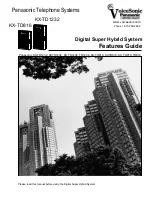
Time mode (day/lunch/break/night) of the preprogrammed tenant is applied to the DID destination and
company greeting number.
PBX
Tenant 1
123-4567
(Company A)
Tenant 2
(Company B)
CO Line Call
Extn. 105
Extn. 102
VPS
(Floating Extn. No. 500)
Intercept
123-2468
CO Line Call
Sends the following information:
·
VM Trunk Group: 1
·
Time mode: Day
Sends the following information:
·
VM Trunk Group: 2
·
Time mode: Lunch
8.
Caller’s Identification Notification to the VPS
When receiving a CO line call, the PBX sends the caller’s identification number/name to the VPS.
9.
DID Number Notification to the VPS
When receiving a CO line call with a DID number, the PBX sends the DID number to the VPS. The number
will be sent to the VPS even if the call reaches the VPS after redirection by, for example, the Intercept
Routing feature.
10.
Status Notification to the VPS
After the call is redirected by the VPS, the PBX sends the status of the redirected extension (e.g., busy)
to the VPS.
11.
Paging by the VPS
The VPS can perform the Paging feature using the recorded message. (
®
13.1.1 Paging)
12.
Live Call Screening (LCS)
A PT or PS user can monitor his own mailbox while a caller is leaving a message and, if desired, answer
the call by pressing the LCS button. When the caller is leaving a message in the mailbox, monitoring can
be carried out in two ways: each PT user can choose which through personal programming (Live Call
Screening Mode Set). PS users cannot choose the way: only Private mode is available for them.
Hands-free mode:
The user can monitor the call automatically through the built-in speaker.
Private mode:
The user will hear a warning tone. To monitor the call, the user goes off-hook with the
handset, MONITOR button, or SP-PHONE button. However, PS users cannot monitor the call with the
speakerphone.
6.1 [4-1-1] Wired Extension—Extension Settings—Option 4—
LCS Answer Mode
13.
Two-way Recording into the VPS
A PT user can record a conversation into his own mailbox or another mailbox, while talking on the phone.
The Two-way Record button is used to record into one’s own mailbox. The Two-way Transfer button is
used to record into someone else’s mailbox.
336
Feature Manual
Document Version 2008-11
19.1.4 Voice Mail DPT (Digital) Integration
Summary of Contents for KX-TDA50G
Page 13: ...Section 1 Features and Configurations A Document Version 2008 11 Feature Manual 13...
Page 26: ...26 Feature Manual Document Version 2008 11 1 1 7 Automatic Time Adjustment...
Page 27: ...Section 2 Features and Configurations B Document Version 2008 11 Feature Manual 27...
Page 30: ...30 Feature Manual Document Version 2008 11 2 1 1 BGM Background Music...
Page 31: ...Section 3 Features and Configurations C Document Version 2008 11 Feature Manual 31...
Page 66: ...66 Feature Manual Document Version 2008 11 3 1 21 CTI Computer Telephony Integration...
Page 67: ...Section 4 Features and Configurations D Document Version 2008 11 Feature Manual 67...
Page 90: ...90 Feature Manual Document Version 2008 11 4 1 11 Doorphone Call...
Page 91: ...Section 5 Features and Configurations E Document Version 2008 11 Feature Manual 91...
Page 102: ...102 Feature Manual Document Version 2008 11 5 1 9 External Sensor...
Page 103: ...Section 6 Features and Configurations F Document Version 2008 11 Feature Manual 103...
Page 124: ...124 Feature Manual Document Version 2008 11 6 1 7 FWD DND Button Group FWD Button...
Page 125: ...Section 7 Features and Configurations G Document Version 2008 11 Feature Manual 125...
Page 130: ...130 Feature Manual Document Version 2008 11 7 1 1 GROUP FEATURES...
Page 131: ...Section 8 Features and Configurations H Document Version 2008 11 Feature Manual 131...
Page 138: ...138 Feature Manual Document Version 2008 11 8 1 6 Hot Line...
Page 139: ...Section 9 Features and Configurations I Document Version 2008 11 Feature Manual 139...
Page 175: ...Section 10 Features and Configurations L Document Version 2008 11 Feature Manual 175...
Page 183: ...Section 11 Features and Configurations M Document Version 2008 11 Feature Manual 183...
Page 193: ...Section 12 Features and Configurations O Document Version 2008 11 Feature Manual 193...
Page 200: ...200 Feature Manual Document Version 2008 11 12 1 5 Operator Features...
Page 201: ...Section 13 Features and Configurations P Document Version 2008 11 Feature Manual 201...
Page 272: ...272 Feature Manual Document Version 2008 11 13 1 28 PT Programming...
Page 273: ...Section 14 Features and Configurations Q Document Version 2008 11 Feature Manual 273...
Page 276: ...276 Feature Manual Document Version 2008 11 14 1 2 Quick Setup...
Page 277: ...Section 15 Features and Configurations R Document Version 2008 11 Feature Manual 277...
Page 283: ...Section 16 Features and Configurations S Document Version 2008 11 Feature Manual 283...
Page 301: ...Section 17 Features and Configurations T Document Version 2008 11 Feature Manual 301...
Page 322: ...322 Feature Manual Document Version 2008 11 17 1 6 TRS Toll Restriction...
Page 323: ...Section 18 Features and Configurations U Document Version 2008 11 Feature Manual 323...
Page 325: ...Section 19 Features and Configurations V Document Version 2008 11 Feature Manual 325...
Page 346: ...346 Feature Manual Document Version 2008 11 19 1 5 Voice Mail DTMF Integration...
Page 347: ...Section 20 Features and Configurations W Document Version 2008 11 Feature Manual 347...
Page 354: ...354 Feature Manual Document Version 2008 11 20 1 4 Wireless XDP Parallel Mode...
Page 355: ...Section 21 Appendix Document Version 2008 11 Feature Manual 355...
Page 373: ...Index Document Version 2008 11 Feature Manual 373...















































